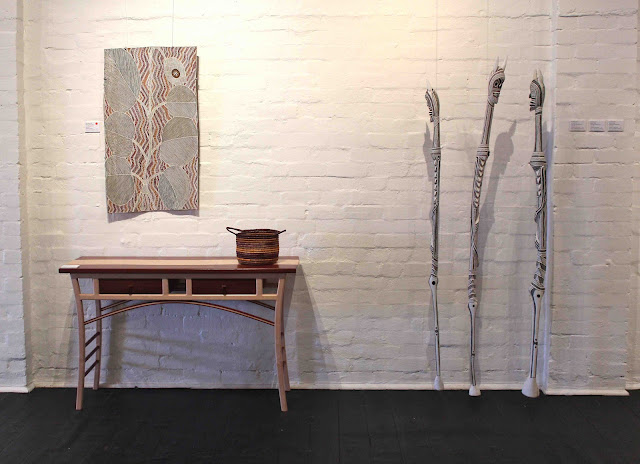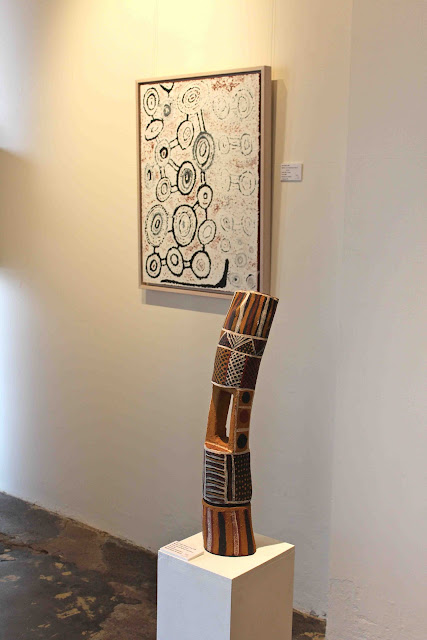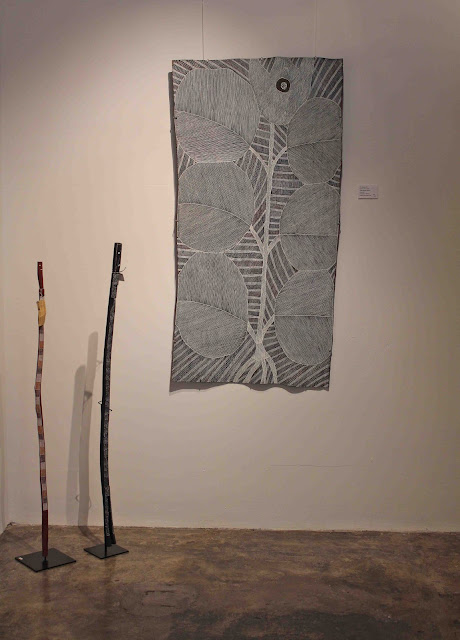Curating has taken over a fair bit from my writing recently, although I have just returned from a research trip to Arnhem Land, Darwin and the Tiwi Islands, to research my next book, on Indigenous warriors in frontier Australia. I lived for a month in beautiful Fannie Bay, Darwin, right by the Fannie Bay Gaol which is the site of a major part of my research. It was a great base for going out and interviewing Indigenous people and artists, and for reading the vast amount of material I have been gathering for the past year or so.
The trip had another purpose as well: sourcing and researching the art of Arnhem Land and the Tiwi Islands, for two exhibitions.
Susan and I visited one of Australia’s biggest and most impressive art centres, Buku-Larrnggay Mulka, at Yirrkala, eastern Arnhem Land, where we had an intensive, unofficial 2 day course in the sophisticated, complex and intellectual art of the Yolngu. I have spent almost a decade reading about the art of these people, before I even dared to visit their home and art centre. So it was great to see the Museum, as well as all the wonderful art in the art centre, the print room, and the Mulka Project. I was particularly impressed by Nyapanyapa Yunupingu’s new work for the Sydney Biennale. I love the way this art centre has such a strong focus on both maintaining traditions and evolving, the combination of traditional art with multimedia is a groundbreaking model that could be used with all kinds of differing wonderful results in many other art centres.
We brought with us the catalogue from my grandfather’s 1965 exhibition of bark paintings from the Melbourne Museum that was held at the Houston Museum of Fine Arts, the first ever exhibition of bark paintings held in America. It took my grandfather 5 years to convince the museum to exhibit the barks, which were literally rotting in a basement. He was even forced to bring in the government to help. He and J.J Sweeney, who had been the inaugural director of the Guggenheim Museum, exhibited them floating in the modernist building, on invisible fishing wire, reflected in the polished concrete floor, with an occasional large potted plant in the room. The effect was stunning. Even today, the hang looks ultra-contemporary. Our family friend Leonard French had built special cases for the barks, many dating from the early part of the twentieth century, and escorted them by ship to America, keeping a close eye on them, as though they were his children. While I was at Buku, a local restorer of the art centre came in. The manager, Will Stubbs, whose knowledge is remarkable and who generously taught me a lot while I was there, showed him the catalogue. He was able to help us identify some of the subject matter of some of the works. Then, he said: one of the bark paintings was by his great-grandfather. So there we were, the granddaughter and the great-grandson, almost fifty years later, pretty much doing the exact same thing as our forebears, art and curating. It was a powerful and moving moment. My grandfather never got to visit Yirrkala, things were different in those days. He would never have dreamt of intruding upon the Yolngu’s home without an expressed invitation. So I am glad that my mother, his daughter, and I, were able to visit this wonderful place all these years later.I also spent a wonderful few days at Munupi Arts, on Melville Island on the Tiwi Islands. I loved everything about Munupi: the dedicated and lovely art centre managers, Terry and Rachel, the artists, who paint and carve in the art centre all day long, while listening to great music, the friendliness and chattiness of the people, the knowledge of the elders, the gorgeous children and the dogs who are always running around, and the art, of course, which I learnt a lot more about. The Tiwi have a strong interest in design, exemplified by their word ‘jilamara’, which means ‘good design’. They are exemplary painters, ceramicists, and sculptors, a unique, strong people who have never, despite generations of visitors, lost their land. We connected so well they invited me to one of their famous pukumani ceremonies, the sculptures of which, as seen in our major public galleries, I have long been such a fan of. I can not wait to visit them again.
The first exhibition, Pattern & Palette, was held at the McCulloch family home on the Mornington Peninsula, and was an exploration of Indigenous artists’ use of colour and design.
The second, ‘Salt of the Earth‘, is part of the annual winter exhibition that we curate with Salt Contemporary in Queenscliff, and is an exploration of artists’ use of the world’s oldest paint: the natural material of ochre.
Over 65 works were sourced from the Kimberley, the Tiwi Islands and Arnhem Land. Exhibiting artists include Queenie McKenzie, Claude Carter, Alan Griffiths, Malaluba Gumana, Lloyd Kwilla, Naminapu Maymuru-White, Nina Puruntatameri, Lilly Roy, Billy Thomas, Freddie Timms, Susan Wanji Wanji, Ralwurrandji Wanambi, Nawurapu Wunungmurra, and others.
We gave an extensive lecture on this art on Sunday May 27 to an enthusiastic audience. There will be a further curators floortalk on Sunday June 10 at 3 pm and the exhibition continues until June 17.Below are some images of this beautiful exhibition.’Salt of the Earth‘
McCulloch & McCulloch @ Salt Contemporary
33 -35 Hesse St Queenscliff Victoria 3225
Tel: +(03) 5258 3988 Email: info@salt-art.com.au www.saltcontemporaryart.com
The trip had another purpose as well: sourcing and researching the art of Arnhem Land and the Tiwi Islands, for two exhibitions.
Susan and I visited one of Australia’s biggest and most impressive art centres, Buku-Larrnggay Mulka, at Yirrkala, eastern Arnhem Land, where we had an intensive, unofficial 2 day course in the sophisticated, complex and intellectual art of the Yolngu. I have spent almost a decade reading about the art of these people, before I even dared to visit their home and art centre. So it was great to see the Museum, as well as all the wonderful art in the art centre, the print room, and the Mulka Project. I was particularly impressed by Nyapanyapa Yunupingu’s new work for the Sydney Biennale. I love the way this art centre has such a strong focus on both maintaining traditions and evolving, the combination of traditional art with multimedia is a groundbreaking model that could be used with all kinds of differing wonderful results in many other art centres.
We brought with us the catalogue from my grandfather’s 1965 exhibition of bark paintings from the Melbourne Museum that was held at the Houston Museum of Fine Arts, the first ever exhibition of bark paintings held in America. It took my grandfather 5 years to convince the museum to exhibit the barks, which were literally rotting in a basement. He was even forced to bring in the government to help. He and J.J Sweeney, who had been the inaugural director of the Guggenheim Museum, exhibited them floating in the modernist building, on invisible fishing wire, reflected in the polished concrete floor, with an occasional large potted plant in the room. The effect was stunning. Even today, the hang looks ultra-contemporary. Our family friend Leonard French had built special cases for the barks, many dating from the early part of the twentieth century, and escorted them by ship to America, keeping a close eye on them, as though they were his children. While I was at Buku, a local restorer of the art centre came in. The manager, Will Stubbs, whose knowledge is remarkable and who generously taught me a lot while I was there, showed him the catalogue. He was able to help us identify some of the subject matter of some of the works. Then, he said: one of the bark paintings was by his great-grandfather. So there we were, the granddaughter and the great-grandson, almost fifty years later, pretty much doing the exact same thing as our forebears, art and curating. It was a powerful and moving moment. My grandfather never got to visit Yirrkala, things were different in those days. He would never have dreamt of intruding upon the Yolngu’s home without an expressed invitation. So I am glad that my mother, his daughter, and I, were able to visit this wonderful place all these years later.I also spent a wonderful few days at Munupi Arts, on Melville Island on the Tiwi Islands. I loved everything about Munupi: the dedicated and lovely art centre managers, Terry and Rachel, the artists, who paint and carve in the art centre all day long, while listening to great music, the friendliness and chattiness of the people, the knowledge of the elders, the gorgeous children and the dogs who are always running around, and the art, of course, which I learnt a lot more about. The Tiwi have a strong interest in design, exemplified by their word ‘jilamara’, which means ‘good design’. They are exemplary painters, ceramicists, and sculptors, a unique, strong people who have never, despite generations of visitors, lost their land. We connected so well they invited me to one of their famous pukumani ceremonies, the sculptures of which, as seen in our major public galleries, I have long been such a fan of. I can not wait to visit them again.
The first exhibition, Pattern & Palette, was held at the McCulloch family home on the Mornington Peninsula, and was an exploration of Indigenous artists’ use of colour and design.
The second, ‘Salt of the Earth‘, is part of the annual winter exhibition that we curate with Salt Contemporary in Queenscliff, and is an exploration of artists’ use of the world’s oldest paint: the natural material of ochre.
Over 65 works were sourced from the Kimberley, the Tiwi Islands and Arnhem Land. Exhibiting artists include Queenie McKenzie, Claude Carter, Alan Griffiths, Malaluba Gumana, Lloyd Kwilla, Naminapu Maymuru-White, Nina Puruntatameri, Lilly Roy, Billy Thomas, Freddie Timms, Susan Wanji Wanji, Ralwurrandji Wanambi, Nawurapu Wunungmurra, and others.
We gave an extensive lecture on this art on Sunday May 27 to an enthusiastic audience. There will be a further curators floortalk on Sunday June 10 at 3 pm and the exhibition continues until June 17.Below are some images of this beautiful exhibition.’Salt of the Earth‘
McCulloch & McCulloch @ Salt Contemporary
33 -35 Hesse St Queenscliff Victoria 3225
Tel: +(03) 5258 3988 Email: info@salt-art.com.au www.saltcontemporaryart.com





